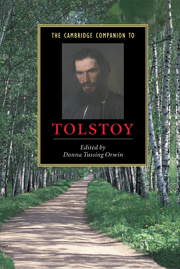Book contents
- Frontmatter
- Chronology
- Introduction
- Part 1 The three novels
- Part 2 Genres
- Part 3 General topics
- 7 The development of style and theme in Tolstoy
- 8 History and autobiography in Tolstoy
- 9 Women, sexuality, and the family in Tolstoy
- 10 Tolstoy in the twentieth century
- 11 Courage in Tolstoy
- 12 Tolstoy’s aesthetics
- Guide to further reading
- Index to Tolstoy’s works and characters
- Generel Index
8 - History and autobiography in Tolstoy
from Part 3 - General topics
Published online by Cambridge University Press: 28 May 2006
- Frontmatter
- Chronology
- Introduction
- Part 1 The three novels
- Part 2 Genres
- Part 3 General topics
- 7 The development of style and theme in Tolstoy
- 8 History and autobiography in Tolstoy
- 9 Women, sexuality, and the family in Tolstoy
- 10 Tolstoy in the twentieth century
- 11 Courage in Tolstoy
- 12 Tolstoy’s aesthetics
- Guide to further reading
- Index to Tolstoy’s works and characters
- Generel Index
Summary
At the end of Sevastopol in May, Tolstoy makes a famous claim, central to his fiction and startling in its simplicity and boldness: “The hero of my tale, whom I love with all the strength of my soul, whom I have attempted to depict in all of his beauty, and who was, is and will always be sublime, is the truth.” In notes toWar and Peace a decade or so later, he wrote: “I was afraid that the necessity to describe the significant figures of 1812 would force me to be governed by historical documents rather than the truth.” But what did Tolstoy mean by “truth” in works of fiction which have, since Aristotle, been understood to describe not what is but what might be?
Given that both works contain this Tolstoyan truth, it makes sense to search for it in their intersection. At first, this approach may seem unpromising, however. Sevastopol in May, a feuilleton, focuses on the day-to-day life of a few “randomly chosen” soldiers during a short period of time in an enclosed space. War and Peace, set entirely in the past, sprawls over multiple characters and huge chunks of time and space. In other ways, however, Sevastopol Sketches and War and Peace are quite similar. Both are constructed of “real” material taken from life (and especially from Tolstoy’s biography), while that same material is fitted into a context that disguises its provenance. Tolstoy was in Sevastopol.
- Type
- Chapter
- Information
- The Cambridge Companion to Tolstoy , pp. 176 - 190Publisher: Cambridge University PressPrint publication year: 2002
- 1
- Cited by

